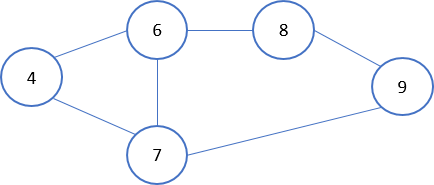Búsqueda de un vértice de grafo mediante BFS
En este ejercicio, modificarás el algoritmo BFS para buscar un vértice dado dentro de un grafo.
Para ayudarte a probar tu código, se ha cargado el grafo indicado a continuación utilizando un diccionario.

graph = {
'4' : ['6','7'],
'6' : ['4', '7', '8'],
'7' : ['4', '6', '9'],
'8' : ['6', '9'],
'9' : ['7', '8']
}
Este ejercicio forma parte del curso
Estructuras de datos y algoritmos en Python
Instrucciones del ejercicio
- Comprueba si has encontrado el valor de búsqueda.
- Devuelve
Truesi has encontrado el valor de búsqueda. - Dentro del bucle
for, comprueba si se ha visitado el vértice adyacente. - Devuelve
Falsesi no has encontrado el valor de búsqueda.
Ejercicio interactivo práctico
Prueba este ejercicio y completa el código de muestra.
import queue
def bfs(graph, initial_vertex, search_value):
visited_vertices = []
bfs_queue = queue.SimpleQueue()
visited_vertices.append(initial_vertex)
bfs_queue.put(initial_vertex)
while not bfs_queue.empty():
current_vertex = bfs_queue.get()
# Check if you found the search value
if ____:
# Return True if you find the search value
____
for adjacent_vertex in graph[current_vertex]:
# Check if the adjacent vertex has been visited
if adjacent_vertex not in ____:
visited_vertices.append(adjacent_vertex)
bfs_queue.put(adjacent_vertex)
# Return False if you didn't find the search value
____
print(bfs(graph, '4', '8'))